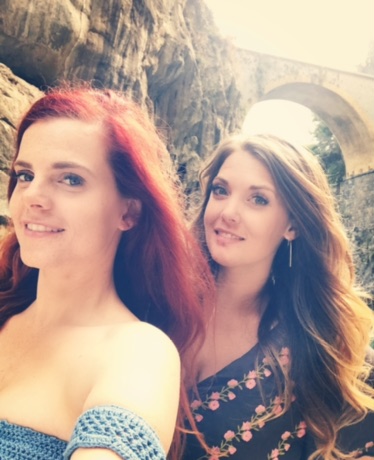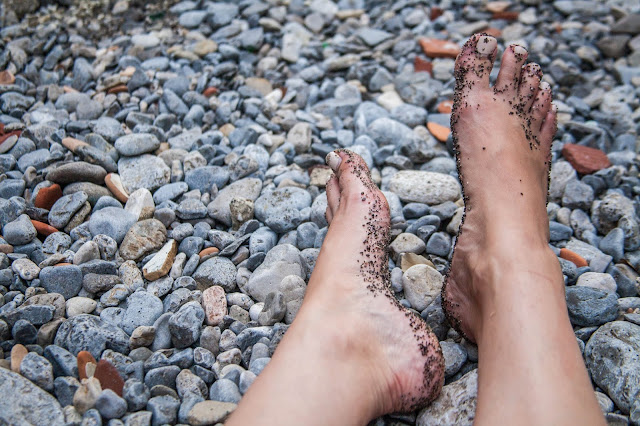Another day on the coast was spent exploring the town of Amalfi. Amalfi is one of the most historic towns along the Amalfi Coast, having had a glorious history as a maritime republic whose status joined the ranks of coastal powerhouses like Pisa, Venice and Genoa. It was a trade bridge between the Byzantine and western worlds for centuries. We had passed through this bustling town several times, but only to get to other destinations, so it was fun to have a day dedicated to exploring all this amazing place has to offer.
We began our day in Amalfi with lunch in the heart of the city in the Piazza Duomo with a perfect view of the gorgeous Amalfi Cathedral.
Since the main product produced and sold in the Amalfi Coast is lemon, there are always several lemon dishes on every menu, and those are the dishes I usually ordered. For this lunch, I ordered the lemon chicken, it was by far the most lemony dish I have ever had. It was full of lemon flavor and was simple and fresh, I really liked that it didn't have any heavy sauces or sides. I did order a caprese salad which was the perfect side dish. It was the perfect Italian coast meal.
After lunch, we took a tour through the stunning Amalfi Cathedral.
The Amalfi Cathedral, also known as the Cathedral of Saint Andrew is a medieval Roman Catholic cathedral, it is dedicated to the Apostle Saint Andrew whose relics are kept there. Sixty-two steps, wide and steep, lead up to the large, bronze doors. Cast in Constantinople before 1066, and signed by Simeon of Syria, the cathedral's bronze doors are the earliest in Italy of post-Roman manufacture.
The front facade was rebuilt in the late 19th century in striped marble and stone, with a tall pediment decorated with mosaics, and a deep porch with windows of delicate Arab-Moorish tracery similar to, but more ornate than, the original.
Begun in 1180, and completed over 100 years later, the Romanesque style bell tower is topped by a cluster of four small towers around a larger one, all decorated with brightly coloured majolica tiles forming interlaced Gothic arches in an Arab-Norman style. This is the most ornate example of type of medieval bell-tower found only in southern Italy.
The best views of the bell tower are from the Cloister of Paradise. The Cloister of Paradise, entered at the left side of the cathedral's portico, is one of the highlights of Amalfi Cathedral. Built between 1266-68 to house the tombs of Amalfi's wealthy merchants, it features slender double columns and Moorish-style arcades made of pure white marble. In the center is a Mediterranean garden; the surrounding walkways are full of notable historic art.
The left walkway has some fine Cosmatesque fragments along with two 2nd-century AD sacrophagi depicting scenes from Greek myth (the Rape of Proserpine and the Wedding of Peleus and Thetis, respectively). Niches in the right-hand walking have damaged frescoes from the 14th century, including a Crucifixion by Roberto d'Orderisio of the Giotto school.
The cloister leads into the Basilica of the Crucifix, dating from the 9th century and containing more frescoes. The basilica now houses the cathedral's museum and treasury. Stairs near the east end descend into the Crypt of St. Andrew, where the saint's relics are kept in the central altar.
The crypt is decorated with beautiful Baroque murals from 1660. There is a large bronze statue of St. Andrew (1604) that was sculpted by Michelangelo Naccherino of Florence, a student of Michelangelo. The marble statues of St. Lawrence and St. Stephen (deacons of the Eastern and Western Church) were sculpted by Pietro Bernini, father of the more famous Gianlorenzo Bernini.
The interior of Amalfi Cathedral is sumptuously Baroque but the underlying architecture is Romanesque. The triumphal arch in the apse is supported by two ancient columns from Paestum. The paintings on the walls and ceilings (by Andrea D'Asta and Castellano in the 18th century) depict the life and miracles of St. Andrew.
The high altar is made from the sarcophagus of Archbishop Pietro Capuano (d.1359), which is decorated with fine bas-reliefs of the Twelve Apostles with St. Basil, St. Nicholas, Jesus and the Virgin Mary. Niches in the right aisle display a large reliquary bust of St. Andrew (16th century) and the Coffin of the Dead Christ, which is carried in solemn procession through Amalfi on Good Friday.
To the right of the altar area is the Chapel of the Relics (a.k.a. Chapel of the Reconciliation), in which are displayed dozens of reliquaries. Some contain relics brought to Amalfi at the same time as those of St. Andrew.
After our tour through the cathedral, V and Reece headed back to Atrani for a nap and a little relaxation. Beth and I boarded a hot, sweaty, noisy, standing-room-only bus to set out on an adventure to find Furore Beach. There isn't an official stop on the bus route for this hidden beach, so we told the bus driver where we wanted to go and he said he would yell to us when to get off, which didn't seem like the most solid of plans, but it was the best we had. Luckily, the girl standing next to us was headed to the same spot, she apparently goes there almost everyday, so she was extremely helpful in letting us know when to get off the bus.
When we got off the bus, we were in the middle of nowhere on a tiny, winding road. Our new friend told us we had to walk a little ways back the way we had come to find the staircase that leads to the beach.
This hidden gem of a beach is actually a fjord or a ria - a narrow gorge cutting inland from the sea, created by the Schiato stream that runs along the mountain to the sea, which is very unusual for Italy and is the main attraction of the tiny village of Furore. If you haven’t heard about this village, do not worry, you are probably not alone. Until recently, the village did not exist on any map. The village Furore is commonly known as “the hidden beauty of Neverland” or "the village that doesn't exist". The village has a long history and tradition, but until few years ago, it wasn’t observed on any map.
The houses in the village are spread on the rocks of the coast of Amalfi, in three small groups. There is no central square, and the village is hidden from the open sea, stretching along the coast. The fjord is the main attraction in the village and is the oldest part of the village, and is commonly known as Fiordo. The village, which consists of around 810 citizens, all live in old fishermen’s houses.
The best time to visit Furore is right before sunset since the sunlight streams in through the narrow passage in the mountain, and you have the perfect view as it slowly diminishes behind the horizon. We tried our hardest to get there before the sun had set too low, but we didn't make it in time. However, since we visited a little later in the day, we practically had the entire beach to ourselves which was so peaceful.
We sat on the beach and listened as the waves gently broke against the shore. There were only a couple of other people on the beach so we enjoyed the people and dog watching. We tested out the water but it was too cold for swimming, so we were content with just relaxing on the shore.
By the water, the pebbles turn into black sand
After soaking in the beautiful views of the Hidden Beauty of Neverland, we ascended the stone staircase back up to the highway.
Once back on the main road, we waited for a bus to take us back to Amalfi. We waited ... and waited ... and waited and while we saw plenty of buses going the other direction, none came for us. Then out of nowhere, a van pulled up next to us and asked if we were going to Amalfi and when we said "yes" the driver motioned for us to get in and said he would take us there for a couple of euros. There were other tourists in the van, so we decided it seemed 70% legit so we hopped on board and hoped we ended up in Amalfi.
Turns out the driver of the van is just a super helpful guy who is making a business of driving lost looking tourists around the Amalfi Coast and getting them where they need to go for a very reasonable price. We were happy we took a chance and got a ride with him, otherwise we would probably still be waiting on the highway.
For dinner that night, we decided to try out a restaurant that is in between Amalfi and Atrani. The path between the two towns runs right down the middle of their patio dining and every time we walked through, we always mentioned how we would like to try eating there sometime. Beth and I walked there from Alalfi and V and Reece walked there from Atrani, it was the perfect meeting place.
The views of the ocean and cliffside towns could not be beat. Our server was an older gentleman who was very serious and had no time for small talk or pleasantries. We caught him smiling and giggling at how cute Vienne was though, and we could tell he had a soft spot for her even though he tried to hide it when he served us.
What a wonderful, and memorable day!






























































